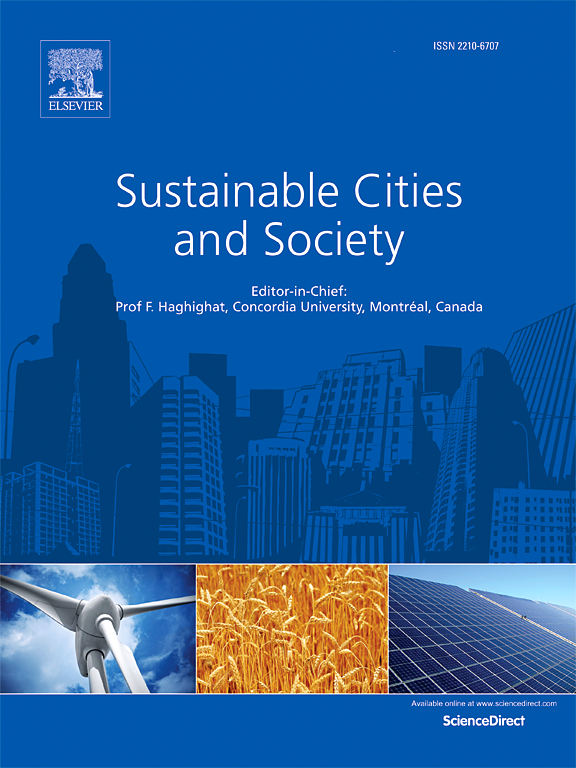A surrogate machine learning modeling approach for enhancing the efficiency of urban flood modeling at metropolitan scales
IF 10.5
1区 工程技术
Q1 CONSTRUCTION & BUILDING TECHNOLOGY
引用次数: 0
Abstract
Urban drainage systems in metropolitan areas are highly complex, posing significant challenges for effective stormwater management. Traditional models like Storm Water Management Model (SWMM) are widely used but become inefficient at large scales with intricate drainage networks. This limitation is particularly critical for early warning systems, which require fast and simplified flood modeling methods. This study investigates surrogate machine learning (ML) models for efficient urban flood modeling at a metropolitan scale. Using SWMM as benchmark, the proposed model demonstrates its ability to replicate SWMM results, offering a more efficient alternative. We partition the system into hydrologically connected clusters, reducing 66,482 manholes to 363 manageable units. The approach combines this clustering strategy with ML modeling to predict key surcharge variables (flood duration, peak, and volume) for individual manholes across complex drainage system. Model validation demonstrates robust performance (R² > 0.8 for extreme events) while reducing computational time by 92.6%. Feature importance analysis reveals depth and duration as primary drivers of flood prediction, with model accuracy correlating to infrastructure density. The surrogate models excel particularly at predicting extreme events, with varying performance across different rainfall conditions. This computational efficiency enables real-time prediction updates crucial for emergency response planning and flood management strategies.
提高大都市尺度城市洪水模型效率的代用机器学习建模方法
大都市地区的城市排水系统非常复杂,对有效的雨水管理提出了重大挑战。暴雨水管理模型(SWMM)等传统模型被广泛使用,但在复杂的大尺度排水网络中效率低下。这一限制对于需要快速和简化的洪水建模方法的早期预警系统尤其重要。本研究探讨了代理机器学习(ML)模型在大都市尺度上的高效城市洪水建模。使用SWMM作为基准,所提出的模型证明了其复制SWMM结果的能力,提供了更有效的替代方案。我们将系统划分为水文连接的簇,将66,482个人孔减少到363个可管理的单元。该方法将这种聚类策略与ML建模相结合,以预测复杂排水系统中单个人孔的关键附加变量(洪水持续时间、峰值和体积)。模型验证显示了稳健的性能(R²>;0.8(极端事件),同时减少92.6%的计算时间。特征重要性分析表明,深度和持续时间是洪水预测的主要驱动因素,模型精度与基础设施密度相关。代理模型尤其擅长预测极端事件,在不同的降雨条件下表现各异。这种计算效率使得实时预测更新对应急响应计划和洪水管理策略至关重要。
本文章由计算机程序翻译,如有差异,请以英文原文为准。
求助全文
约1分钟内获得全文
求助全文
来源期刊

Sustainable Cities and Society
Social Sciences-Geography, Planning and Development
CiteScore
22.00
自引率
13.70%
发文量
810
审稿时长
27 days
期刊介绍:
Sustainable Cities and Society (SCS) is an international journal that focuses on fundamental and applied research to promote environmentally sustainable and socially resilient cities. The journal welcomes cross-cutting, multi-disciplinary research in various areas, including:
1. Smart cities and resilient environments;
2. Alternative/clean energy sources, energy distribution, distributed energy generation, and energy demand reduction/management;
3. Monitoring and improving air quality in built environment and cities (e.g., healthy built environment and air quality management);
4. Energy efficient, low/zero carbon, and green buildings/communities;
5. Climate change mitigation and adaptation in urban environments;
6. Green infrastructure and BMPs;
7. Environmental Footprint accounting and management;
8. Urban agriculture and forestry;
9. ICT, smart grid and intelligent infrastructure;
10. Urban design/planning, regulations, legislation, certification, economics, and policy;
11. Social aspects, impacts and resiliency of cities;
12. Behavior monitoring, analysis and change within urban communities;
13. Health monitoring and improvement;
14. Nexus issues related to sustainable cities and societies;
15. Smart city governance;
16. Decision Support Systems for trade-off and uncertainty analysis for improved management of cities and society;
17. Big data, machine learning, and artificial intelligence applications and case studies;
18. Critical infrastructure protection, including security, privacy, forensics, and reliability issues of cyber-physical systems.
19. Water footprint reduction and urban water distribution, harvesting, treatment, reuse and management;
20. Waste reduction and recycling;
21. Wastewater collection, treatment and recycling;
22. Smart, clean and healthy transportation systems and infrastructure;
 求助内容:
求助内容: 应助结果提醒方式:
应助结果提醒方式:


